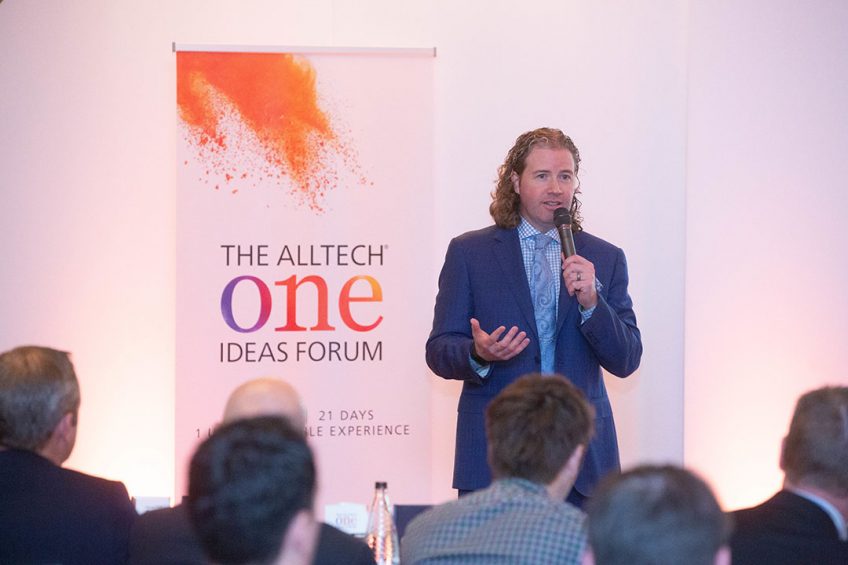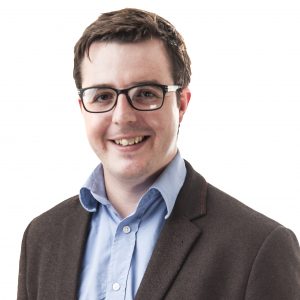Alltech’s Mark Lyons – In his father’s footsteps

Mark Lyons succeeded his father as president of the global animal nutrition business Alltech this year. He sat down with Poultry World to discuss the direction of the business and the legacy left by his dad.
The global animal nutrition company Alltech brought a flavour of its Ideas conference to Birmingham in November.
For those who haven’t attended the firm’s week-long jamboree, some explanation may be necessary. More than 3,500 people descend on Lexington, Kentucky, where the firm hails from and, over the course of the event, you are as likely to hear about poultry nutrition as from an Apple executive. Or an operatic solo. Or some Irish dancing.
Sound a bit eccentric? It was a cornerstone of the calendar for Alltech’s late founder Pearse Lyons, who stood at the centre of proceedings and eulogised his belief in the power of an entrepreneurial spirit to his employees and customers. Dr Lyons died shortly before this year’s conference, leaving the company he founded in the hands of his son, Mark.
Born in the business
He is no stranger to Alltech. He travelled widely with his parents from an early age, visiting customers across the world, and later followed in his father’s footsteps by gaining postgraduate qualifications in brewing and distilling. Mark’s first posting was to gain experience at a joint venture in Mexico, where he was initially supposed to spend six months. The business wasn’t going well, and so his father suggested Mark was put in charge. “I was completely out of my depth,” he recalls, but the move was characteristic – “my father engaged with young people, gave them real responsibility”.
Far from being unique to the founders’ son, scholarships and building science labs in schools are two examples of this support for emerging talent – more than 2,000 people apply for the Alltech Young Scientist competition each year.
After that first posting, which lasted four years in the end, he managed a broad range of interests within Alltech, before heading the North American business between 2009 and 2011. The next step was relocating to China, where he spent time leading Alltech in the Asia-Pacific region, building links between the business and what is the world’s largest animal feed market.
Over the past few weeks Mark has been heading up a lecture tour of the markets in which Alltech operates, embarking upon whistle-stop visits to the US, Europe and Asia Pacific, comprising 16 events in total over about four weeks. It is a chance for Dr Lyons junior to show his face in front of customers, and explain how the business will develop under his leadership.
At one of those stops, in a hotel close to Birmingham Airport, Dr Lyons junior told Poultry World about his father’s legacy, and how he plans to lead the multi-billion dollar business.
Private company
A fundamental element of Dr Lyons senior’s philosophy when it comes to business was control through private ownership. “It was a big belief of my father’s that it is a huge strategic advantage to be private because, as he liked to put it, he was only responsible to himself for his own idiocy; if he made a mistake he only had to answer to himself,” says Mark.
But more seriously, it allows for fast decision making, requires a long-term mentality and avoids the importance that public companies must place on shareholder value – that last requirement, he says, can take “an enormous amount of their energy and focus away from the proper running of a business”.
Instead, a “flat structure” where employees are in constant contact with top brass and a culture in which “everyone in the company is in sales” are fundamental tenets of the entire operation, which was started in 1980 from Dr Lyons’ garage with a $ 10,000 loan.
Aquisitions
“Alltech traditionally had an organic growth model, we went into new markets and each year added one or two, and that’s how we’ve ended up trading in over 120 countries,” he says. “But in the past five-to-seven years we’ve moved into acquisitions.
“What we’re looking at now is how we can leverage some of the capabilities that have come into the organisation.”
Those acquisitions include feed nutrition businesses, like Coppens, and Montana-based Westfeeds – natural fits for a nutrition business. Keenan, however, – a manufacturer of feed wagons – marked a change in strategy for the company. Mark explains the business was bought over a weekend; after he heard the company was in some trouble, his father stepped in and snapped it up. “That’s the speed of Alltech, that’s the speed that creates differentiating factors.” The reason for the purchase? Linking nutrition with feed delivery to monitor when and how animals are eating.
“We can know when an animal is eating and create a platform for so many different types of technologies, that’s the vision.”
It ties in with the advances in the understanding of not just the best formulations for animal diets, but also when and how to present the feed to best effect – and that centres around Nutrigenomics, understanding how the body responds to food. “I think that technology is really coming of age, we’re seeing it’s not just what types of components we’re feeding to animals, it’s also the timing. That timing even based and connected to nature into natural cycles.
“That’s a total transformation about what we’re thinking with a normal feed formulation, and the assumption that the most important thing is a certain number of calories, protein, calcium phosphorus or whatever the key components are – what we’re finding is that’s not necessarily true.
“The limiting factor today is not just the nutritional concepts, it’s how do we get that food in front of an animal at the time we want it to? It probably means reimagining the way we feed animals and design farms today.”
Access to feed
But that throws up additional challenges. “How do you get this feeding system in place that gets what you want in front of the animal when you want it there? This brings us to the second aspect which is a real total transformation of technology coming into agriculture.”
While the business has made acquisitions, Mark says it is in collaboration with companies that he sees the most potential. “The areas in which we see the biggest opportunity is collaboration. This is truly the way great innovations take place.”
And this collaboration is most apparent in the Pearse Lyons accelerator, which is now in its third year. “It invites late-stage entrepreneurs with a concept that they’ve been able to prove who really need that leap forward in terms of coaching and help to sell. The biggest thing we’ve been able to achieve is bridging the gap between industry and ag tech – and we want to demystify one to the other and make sure that they work in a collaborative way.”
Join 31,000+ subscribers
Subscribe to our newsletter to stay updated about all the need-to-know content in the poultry sector, three times a week. Beheer
Beheer











 WP Admin
WP Admin  Bewerk bericht
Bewerk bericht